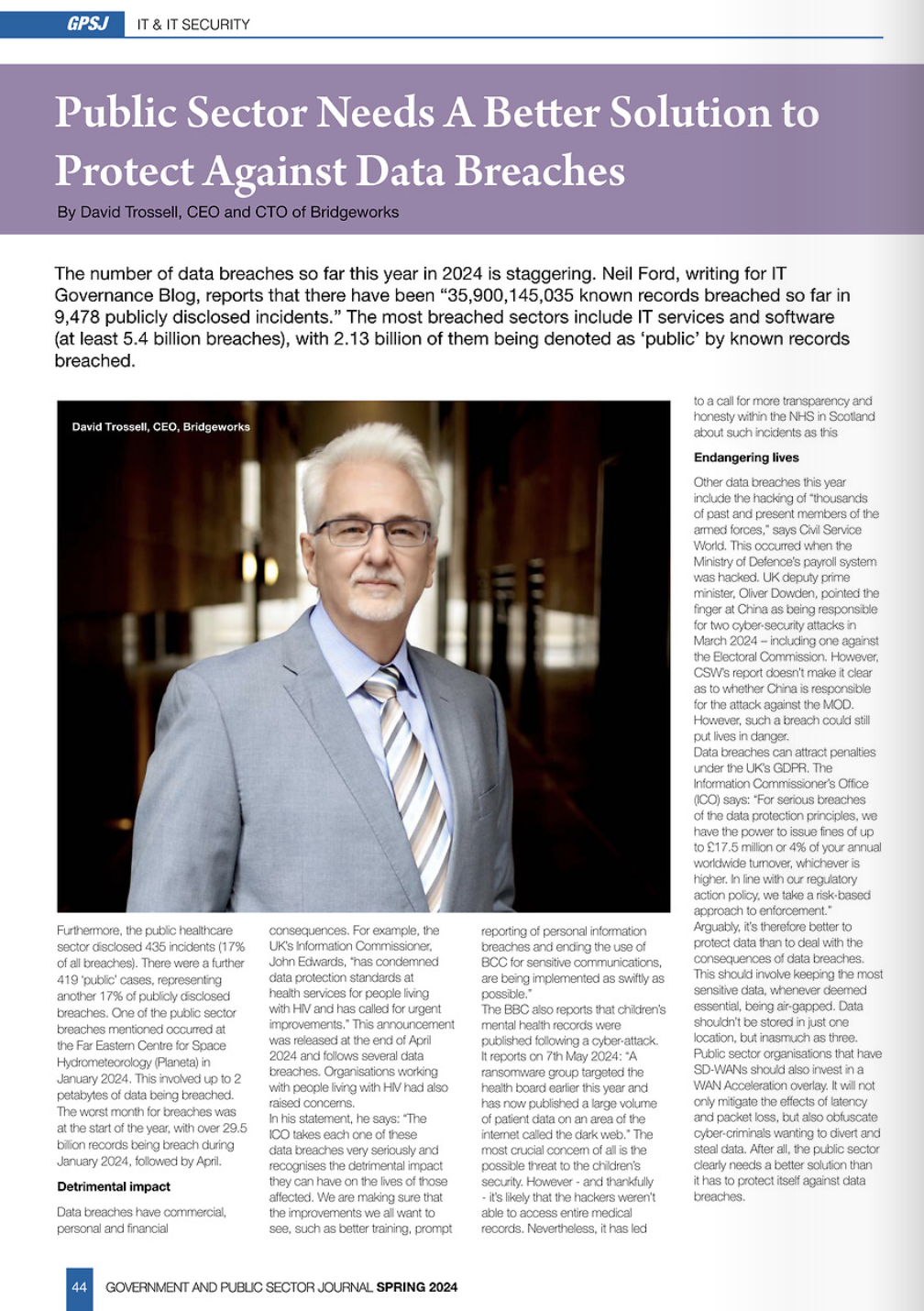David Trossell, CEO of Bridgeworks features in this article form HealthTech World Magazine to discuss the benefits of WAN Acceleration for patient data management.

April 12, 2023
With increasing digital transformation, hospitals around the world are becoming more reliant on their Wide Area Networks (WANs).
They are needed for sharing electronic medical records, MRI scans, working collaborative on medical research projects, and so on. The trouble is that WANs can be inhibited by latency and packet loss, reducing bandwidth utilisation. The most common approaches to try to mitigate them include SD-WANs, WAN Optimisation, and buying more bandwidth. Unfortunately, they often don’t live up to their promise. That said, New South Wales, Australia, has pushed for the creation of the Health Wide Area Network (HWAN) to connect hospitals, health centres, and data centres within the State. The key aim is to allow its healthcare systems to share communications, data and resources.
The HWAN also “underpins the statewide rollout of advanced clinical and corporate applications and services, ensuring patient information can be safely stored and securely transferred when and where it is needed,” says eHealth NSW.
Performance and reliability
Like with most organisations, the key requirement is to have a network that offers increased performance and reliability, which are prerequisites for frontline clinical and real-time applications. These include electronic medical record (eMR) systems, and a need for electric medication management (eMeds). Both are critical to better patient care, and to ensure that all regulations, best practices, procedures and legislation is followed to the letter to prevent injury, death, and litigation. Now their network might be highly performant, but that doesn’t mean it couldn’t do better. After all latency and packet loss often impinge on the performance and reliability of Wide Area Networks (WANs), so is the answer for NSW eHealth, and other healthcare organisations around the world, is often to create a dedicated network “to connect individual health facilities across the State and to support data exchange, multimedia such as voice and video as well as real-time streaming of data.”
Key priorities
The State says the key priorities of the HWAN are to create:
- Access to Government Data Centres (GovDC): to support shifts towards ‘as a service’ models.
- A private wide area network (WAN): dedicated virtual routing and forwarding (VRF) providing a multi-tenanted routing domain within the HWAN Core for individual health facilities.
- A dedicated internet and extranet platform: A private virtual firewall across GovDC enabling secure connectivity to the Internet, DMZ and extranet.
- Subscription to third-party extranet services: giving the ability for third-parties who service multiple health facilities to connect to HWAN and be delivered on-demand securely to any health facility across the state.
HWAN time-savings
The New South Wales HWAN was first created in 2019, and today the State says it plays a vital role as a high-speed backbone for the delivery of clinical systems. The State says it has, since the 2019 roll-out, achieved significant time savings to the extent that the HWAN has reduce application implementation processes from an average of 600 hours to just 12 hours. On the face of it that’s sounds quite impressive, but it’s not the full extent of NSW’s plans. The project is very much ongoing, with a view to enhance its existing infrastructure, security, and intelligence capabilities. It says this includes “accelerating its support of cloud-based services” and strengthening collaboration with regional and rural local health districts. This should enable the State’s healthcare organisations to respond to specific challenges to make improvements.
HWAN benefits
eHealth NSW says there are many significant benefits to its HWAN platform. They range from increased agility with the ability to reduce network delivery lead times, and the simplification and acceleration of deployment. It claims that performance is improved too. With the HWAN there is a much focus on cyber-security and network accessible resources to deliver a better user experience. It says the HWAN approves efficiency and versatility for managing third-party connectivity.
Other benefits include the enabling of cloud adoption to permit health facilities to be connected to cloud services and the public Internet with enterprise grade reliability and performance; new levels of efficiency and versatility for managing third-party connectivity; enterprise grade solutions can be scaled to meet the demands of cross-facility interactions; standardised hardware with guaranteed maintenance or replacement; centralised management with secure access; flexibility for any Local Area Network (LAN) configuration; and 24/7 monitoring and alerts.
HWAN refresh delay
Despite these claims, not everything seems so rosy for State’s HWAN. Pulse IT News reported on 26th April 2022 that eHealth NSW delayed the closing data for its $10m core network refresh project, which is meant to upgrade HWAN to allow it to support telehealth, Wi-Fi, and applications across the State with a view of developing a Network-as-a-Service configuration. Although it’s not quite clear what technologies are involved in a HWAN, by building a dedicated network for healthcare organisations across New South Wales, more control is gained over the network, its security and development. If the State were to have several WANs across the network, it would face increased complexity of how each network integrates, is secured, and managed.
Doing more with less
Despite this advantage, there is still the question about whether healthcare organisations in Australia and around the world really need to ‘modernise’ their existing infrastructure. They could be getting more out of the infrastructure they already have – including for the development of a healthcare WAN.
David Trossell, CEO and CTO of UK firm Bridgeworks explains:
“While New South Wales seems to have achieve a significant increase in performance with the adoption and development of its HWAN, there is always the potential for healthcare organisation to do more with the infrastructure they already have – including for the benefit of being able to access medical and healthcare cloud services.
“This can be achieved using artificial intelligence, machine learning, and data parallelisation.”
That’s essentially WAN Acceleration. So, if the HWAN is based on SD-WANs, then it could benefit from having a SD-WAN-WAN Acceleration overlay, which could boost its performance beyond what has already been achieved. WAN Acceleration can also send and receive encrypted data in ways that WAN Optimisation fails to achieve while also increasing network speed, overall performance, increased bandwidth utilisation, reliability, and security.
Cyber-attacks increase
In these times when cyber-attacks are increasing – including upon healthcare organisations, it’s vital to have a solution such as WAN Acceleration to enable fast backups and restores – including Backup-as-a-Service (BaaS).
Trossell explains:
“Cyber-attacks are now occurring to the backup software and backup media. Having robust firewalls and anti-virus protection, as well as some new artificial intelligence (AI) driven virus detection, and air-gapped backups ensure that sensitive and critical data is unattainable to the cyber criminals. It is vital to realise that until that last “back-up byte” leaves your premises, you haven’t got a complete backup. Therefore, the quicker that data is offsite, the better. Having an efficient method of moving data across the WAN could allow intermediate backups during the day, which can drastically reduce the Recovery Point Objectives (RPO) and Recovery Time Objectives (RTO).”
There is also the matter of ongoing concern: the prospect of an ongoing recession, which could be exacerbated by a looming banking crisis, should also make healthcare and medical organisations think about sweating their existing assets to maximise their returns on investment (ROI). Economic and financial pressures tend to affect everyone, and so spending millions on new infrastructure may be desirable but not absolutely sensible right now.
WAN Acceleration helps
This is where Trossell says WAN Acceleration can help. By maximising the throughput of the existing WAN architecture, organisations can experience between 10 and 40 times improvements in the performance of their WAN: enabling them to put off an upgrade to more expensive, and higher bandwidth links. Reducing IT costs while improving network performance could also advance patient care, so long as medical and healthcare investments are made appropriately to improve it. The trouble is that, even in the UK, public sector IT projects often fail. Healthcare and medical organisations should think carefully about want they want to achieve and work with partners that improve their performance while saving them time, resources, and money. Trossell believes WAN Acceleration can do this for any country or state, and for any healthcare or medical organisation. He knows full well what’s possible because of Bridgeworks’ work with the National Institutes of Health and CVS Healthcare in the United States. So, even the HWAN could be boosted with WAN Acceleration.
Click here to read the article on Health Tech World Magazine.




